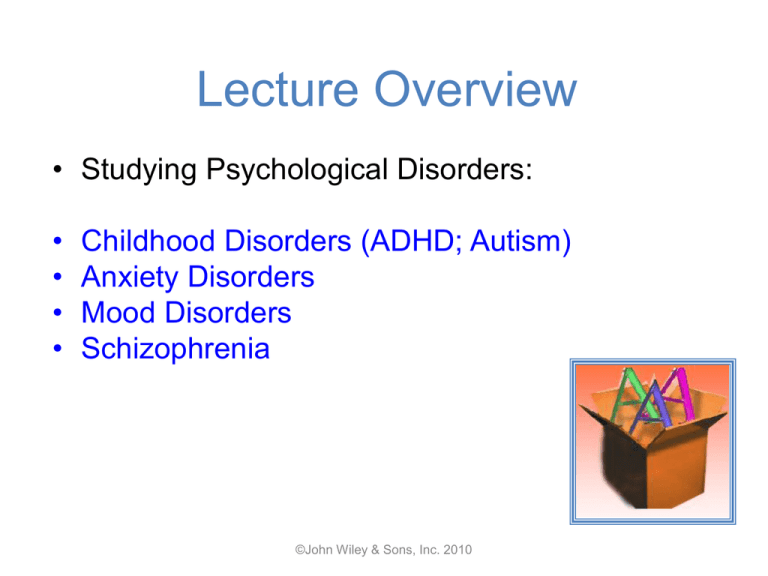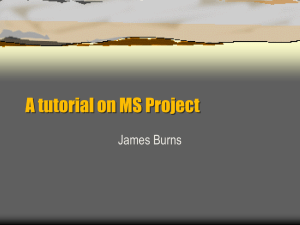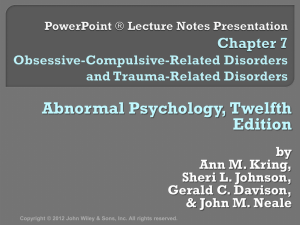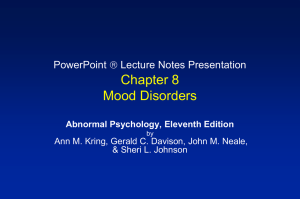Chapter 14
advertisement

Lecture Overview • Studying Psychological Disorders: • • • • Childhood Disorders (ADHD; Autism) Anxiety Disorders Mood Disorders Schizophrenia ©John Wiley & Sons, Inc. 2010 Studying Psychological Disorders • Abnormal Behavior: patterns of emotion, thought, & action considered pathological for one or more of four reasons: • statistical infrequency • disability or dysfunction • personal distress • violation of norms ©John Wiley & Sons, Inc. 2010 Studying Psychological Disorders: Four Criteria for Abnormal Behavior ©John Wiley & Sons, Inc. 2010 • Culture-General Symptoms: shared symptoms across cultures ©John Wiley & Sons, Inc. 2010 Studying Psychological Disorders (Continued) • Historical perspectives: – In ancient times, people believed demons were the cause of abnormal behavior, & boring holes in the skull (trephining) allowed evil spirits to escape. – In the 19th Century the medical model of psychiatric diseases began to take hold. ©John Wiley & Sons, Inc. 2010 Studying Psychological Disorders (Continued) • Modern psychology includes seven major perspectives on abnormal behavior. ©John Wiley & Sons, Inc. 2010 Studying Psychological Disorders: Classifying Abnormal Behavior • Diagnostic & Statistical Manual of Mental Disorders (DSM-IV-TR): • provides detailed symptom descriptions • contains over 200 diagnostic categories grouped into 17 major categories & five dimensions (or axes) ©John Wiley & Sons, Inc. 2010 Studying Psychological Disorders: Classifying Abnormal Behavior (Cont.) • Five Axes of DSM-IV-TR (guidelines for making decisions about symptoms) • • • • Axis I (current clinical disorders) Axis II (personality disorders & mental retardation) Axis III (general medical information) Axis IV (psychosocial & environmental problems) • Axis V (global assessment of functioning) ©John Wiley & Sons, Inc. 2010 ©John Wiley & Sons, Inc. 2010 Key Points: 1)Differential Diagnoses 2)People with psychiatric diagnoses also commonly suffer comorbidity with Substance-related disorders ©John Wiley & Sons, Inc. 2010 • ADHD: Attention Deficit Hyperactivity Disorder • Historically called Minimal Brain Damage or Dysfunction (MBD) ; Attention Deficit with or without Hyperactivity (ADD , ADD+ H). • Problems with Diagnoses? ©John Wiley & Sons, Inc. 2010 • DSM-IV (TR) AttentionDeficit/Hyperactivity Disorder A. Persistent pattern of inattention and/or hyperactivity-impulsivity that is more severe than is typically observed in individuals at comparable level of development. B. Some hyperactive-impulsive or ©John Wiley & Sons, Inc. 2010 C. Some impairment from the symptoms must be present in at least two settings. D. There must be clear evidence of interference with developmentally appropriate social, academic or occupational functioning. E. ADHD primarily hyperactive ADHD primarily inattentive ©John Wiley & Sons, Inc. 2010 • Deficits in Executive Function: Wisconsin Card Sort Test ©John Wiley & Sons, Inc. 2010 • Stroop Test: • BLUE • RED • GREEN BLUE RED GREEN ©John Wiley & Sons, Inc. 2010 ©John Wiley & Sons, Inc. 2010 • ADHD results in Problems of Executive Function: • Planning • Working Memory ** • Sustaining Attention • Resisting Distraction • Organizing • Stopping and Starting Behavior ** remembering so as to do ©John Wiley & Sons, Inc. 2010 • Pervasive Developmental Disorders • Autism • High- functioning • Low-functioning • Asperger’s Syndrome ©John Wiley & Sons, Inc. 2010 Autistic children have deficits in: • Social interaction (Theory of Mind) • Language and communication • Imaginative play • Range of interest and activity ©John Wiley & Sons, Inc. 2010 Asperger’s Syndrome in children produces: Odd language (stilted prosody) Deficit in social interaction Fixation in interest Diagnosed later than Autism; fewer severe behavior problems ©John Wiley & Sons, Inc. 2010 Anxiety Disorders • • 1. 2. 3. 4. 5. Anxiety Disorder: overwhelming apprehension & fear accompanied by autonomic nervous system (ANS) arousal Five Major Types: Generalized Anxiety Disorder Panic Disorder Phobias Obsessive-Compulsive Disorder (OCD) Posttraumatic Stress Disorder (PTSD) ©John Wiley & Sons, Inc. 2010 Five Types of Anxiety Disorders 1. Generalized Anxiety Disorder: persistent, uncontrollable, & free-floating anxiety 2. Panic Disorder: sudden & inexplicable panic attacks ©John Wiley & Sons, Inc. 2010 Anxiety Disorders (Continued) 3. Phobia: intense, irrational fear & avoidance of a specific object or situation 4. Obsessive-Compulsive Disorder (OCD): intrusive, repetitive, fearful thoughts (obsessions), with urges to perform repetitive, ritualistic, behaviors (compulsions), or both ©John Wiley & Sons, Inc. 2010 Anxiety Disorders (Continued) 5. Posttraumatic Stress Disorder (PTSD): anxiety disorder following extraordinary stress ©John Wiley & Sons, Inc. 2010 Explanations of Anxiety Disorders • Psychological--faulty cognitions, maladaptive learning • Biological--evolution, genetics, brain functioning, biochemistry • Sociocultural—environmental stressors, cultural socialization ©John Wiley & Sons, Inc. 2010 Mood Disorders • Mood Disorders: characterized by extreme disturbances in emotional states • Two Main Types of Mood Disorders: • Major Depressive Disorder: long-lasting depressed mood that interferes with the ability to function, feel pleasure, or maintain interest in life ©John Wiley & Sons, Inc. 2010 Bipolar Disorder: • repeated episodes of mania & depression ©John Wiley & Sons, Inc. 2010 Mood Disorders (Continued) • Note how major depressive disorders differ from bipolar disorders on this hypothetical graph. ©John Wiley & Sons, Inc. 2010 Explanations of Mood Disorders – Biological--brain functioning, neurotransmitter imbalances, genetics – Psychosocial--environmental stressors, disturbed interpersonal relationships, faulty thinking, poor selfconcept, learned helplessness, faulty attributions ©John Wiley & Sons, Inc. 2010 Mood Disorders (Continued) • Gender & Cultural Diversity: – Culture-general symptoms for depression (e.g., sad affect, lack of energy) – Women more often depressed. Why? Combination of biological, psychological, & social forces (biopsychosocial model) ©John Wiley & Sons, Inc. 2010 Biological Social Psychological Schizophrenia • • 1. 2. 3. 4. 5. Schizophrenia: group of psychotic disorders, characterized by a general loss of contact with reality Five areas of major disturbance: Perception (hallucinations) Language (word salad, neologisms) Thoughts (psychosis, delusions) Emotion (exaggerated or flat affect) Behavior [unusual actions (e.g., catalepsy, waxy flexibility)] ©John Wiley & Sons, Inc. 2010 Subtypes of Schizophrenia ©John Wiley & Sons, Inc. 2010 Schizophrenia (Continued) • Explanations of Schizophrenia: – Biological: genetic predisposition, disruptions in neurotransmitters, brain abnormalities – Psychosocial: diathesis-stress model, disturbed family communication ©John Wiley & Sons, Inc. 2010 Genetics & Schizophrenia ©John Wiley & Sons, Inc. 2010 Schizophrenia (Continued) • Gender & Cultural Diversity: Numerous culturally general symptoms, but significant differences exist in: • prevalence • form • onset • prognosis ©John Wiley & Sons, Inc. 2010









